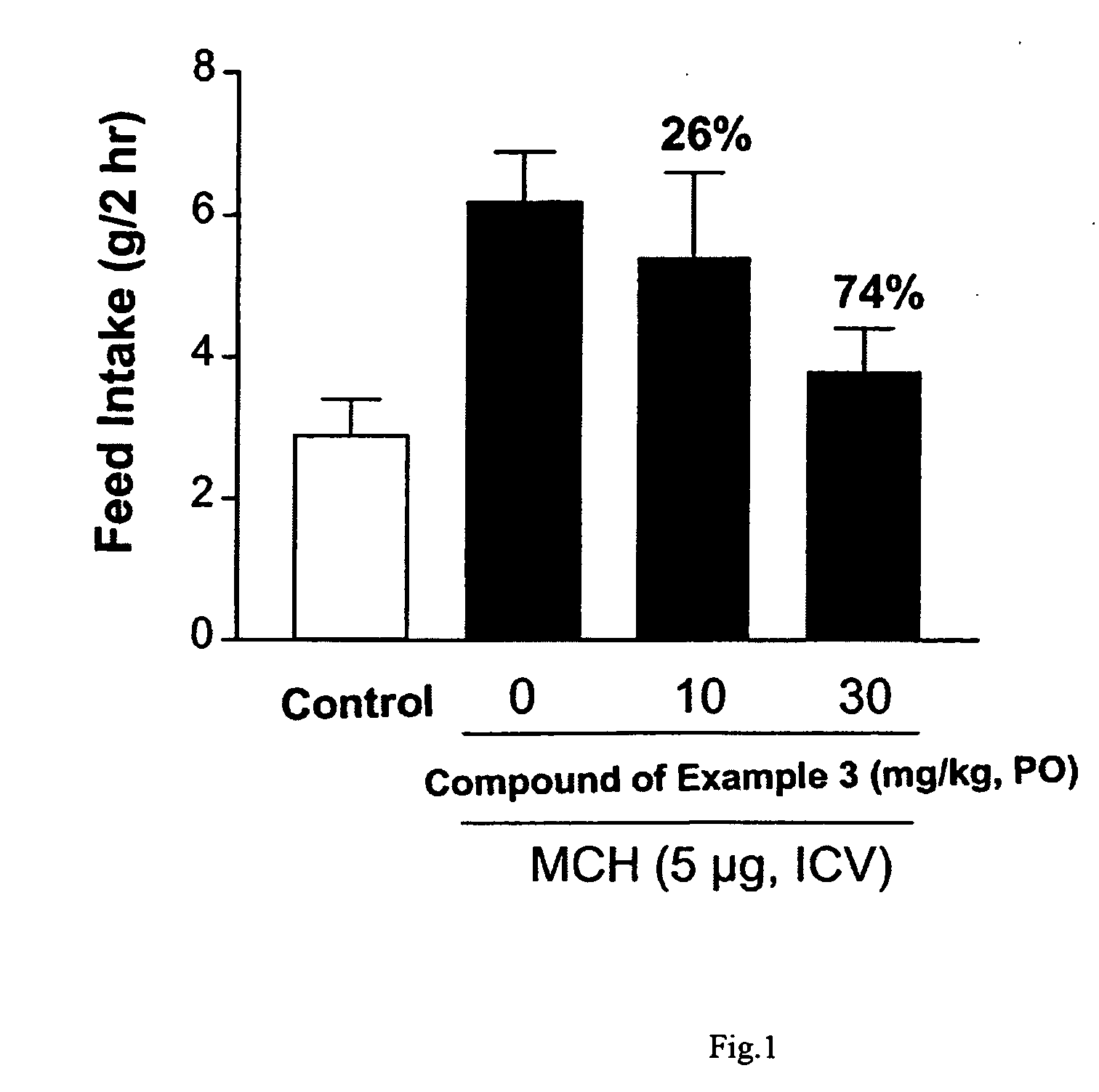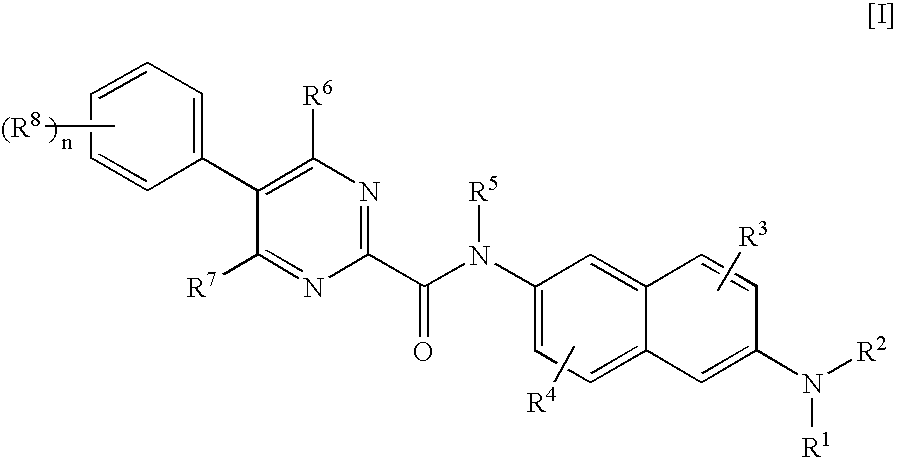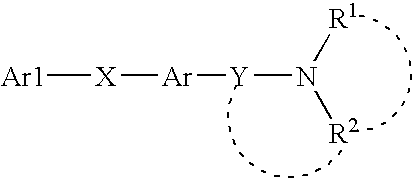2-Aminoquinoline derivatives
a technology of aminoquinoline and derivatives, applied in the field of aminoquinoline derivatives, can solve the problems of not being easy to conceive, and achieve the effects of high selectivity, potent mch-1r antagonistic activity, and excelling in oral absorption and intracerebral transmigration
- Summary
- Abstract
- Description
- Claims
- Application Information
AI Technical Summary
Benefits of technology
Problems solved by technology
Method used
Image
Examples
referential example 1
1-Methyl-7-(6-nitro-2-quinolinyl)-2-oxo-1, 7-diazaspiro[4,4]-nonane
[0207] (1) To a solution of diisopropylamine (12 ml) in THF (200 ml), n-butyl lithium (2.6 M-hexane solution, 32 ml) was added under cooling with ice, followed by 20 minutes' stirring at the same temperature. The solution was then cooled to −78° C. and into which a THF solution (30 ml) of 1-(tert-butyl)3-methyl 1,3-pyrrolidine-dicarboxylate (13.0 g) was added dropwise, followed by an hour's stirring at the same temperature. Then allyl bromide (10 ml) was added to the reaction liquid, followed by an hour's stirring at −78° C. and another hour's stirring at room temperature. Saturated aqueous ammonium chloride solution was added to the reaction liquid which was subsequently extracted with ethyl acetate. The resulting ethyl acetate layer was dried over anhydrous sodium sulfate and concentrated under reduced pressure. The residue was subjected to column chromatography (hexane:ethyl acetate=15:1) to provide 1-(tert-butyl...
referential example 2
7-Methyl-2-(6-nitro-2-quinolinyl)-8-oxo-2,7-diazaspiro[4,4]-nonane
[0213] (1) A solution of 3-pyrrolidinol (4.0 g) in dioxane-water (10:1, 50 ml) mixed solvent was cooled to 5° C., and into which a solution of 4-nitrobenzyl chloroformate (10.9 g) in dioxane (20 ml) was added dropwise, while maintaining the pH at 8-9, followed by 10 minutes' stirring at 5° C. Distilling the solvent off under reduced pressure, the residue was extracted with ethyl acetate. The organic layer was dried over anhydrous magnesium sulfate, and from which the solvent was distilled off under reduced pressure. Washing the residue with ethyl acetate, 3-hydroxy-1-(p-nitrobenzyloxycarbonyl)pyrrolidine (6.6 g) was obtained as a pale yellow solid.
[0214] (2) A solution of the compound as obtained in (1) (6.3 g) and triethylamine (26.5 ml) in DMSO (76 ml) was cooled to 110° C., to which pyridine sulfur trioxide complex (11.3 g) was added. After stirring the system an overnight at room temperature, water was added to ...
referential example 3
(3R)-N-methyl-N-[1-(6-nitro-2-quinolinyl)-3-pyrrolidinyl]-isobutylamide
[0223] (1) To a solution of (3R)-(−)-1-benzyl-3-(methylamino)-pyrrolidine (20.0 g) in tetrahydrofuran (200 ml), triethylamine (29.3 ml) and di-tert-butyl-dicarbonate (34.4 g) were added at 0° C., followed by stirring an overnight at room temperature. Water was added to the reaction liquid which then was extracted with diethyl ether. The organic layer was washed with saturated saline, dried over anhydrous sodium sulfate, and concentrated under reduced pressure. To the residue 4N hydrochloric acid-ethyl acetate solution (29.0 ml) was added, and formed white crystals were washed with diisopropyl ether, and filtered. Drying the product, tert-butyl (3R)-N-(1-benzyl-3-pyrrolidinyl)-N-methylcarbamate hydrochloride (24.2 g) was obtained as white crystals. ESI-MS Found: m / z 235[M+H]+
[0224] (2) To a solution of the compound as obtained in above (1) (22.0 g) in methanol (225 ml), 10% palladium-on-carbon (7.2 g) was added i...
PUM
| Property | Measurement | Unit |
|---|---|---|
| Mass flow rate | aaaaa | aaaaa |
Abstract
Description
Claims
Application Information
 Login to View More
Login to View More - R&D
- Intellectual Property
- Life Sciences
- Materials
- Tech Scout
- Unparalleled Data Quality
- Higher Quality Content
- 60% Fewer Hallucinations
Browse by: Latest US Patents, China's latest patents, Technical Efficacy Thesaurus, Application Domain, Technology Topic, Popular Technical Reports.
© 2025 PatSnap. All rights reserved.Legal|Privacy policy|Modern Slavery Act Transparency Statement|Sitemap|About US| Contact US: help@patsnap.com



